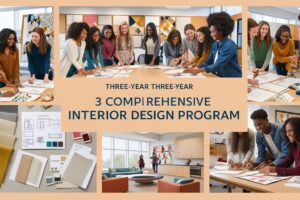
Elevate Spaces: Exploring the World of Interior Design Courses
Embarking on a journey in interior design is more than a career choice; it’s an opportunity to transform spaces and enhance the lives of those who inhabit them. This guide navigates through the diverse world of interior design courses, providing insights into how these programs, rooted in a people-first philosophy, empower individuals to elevate spaces with creativity and expertise.
The Foundation: Basics of Interior Design
Introduction to Design Principles
Interior design courses often commence with an introduction to fundamental design principles. Understanding concepts like balance, harmony, contrast, and rhythm lays the groundwork for creating aesthetically pleasing and functional spaces.
Spatial Awareness and Planning
Courses delve into spatial awareness and planning, teaching students how to optimize room layouts, consider traffic flow, and utilize space efficiently. This knowledge forms the basis for crafting designs that are both visually appealing and practical.
Developing Design Expertise
Color Theory and Material Selection
Interior designers harness the power of color and materials to evoke emotions and create atmospheres. Courses explore color theory, material selection, and the psychology behind design choices, enabling students to make informed decisions in their projects.
Furniture and Lighting Design
Understanding the nuances of furniture and lighting design is integral. Interior design courses delve into styles, ergonomics, and the transformative impact of lighting, empowering students to curate spaces that are comfortable and visually captivating.
Embracing Technological Advancements
Digital Tools and 3D Visualization
In the digital age, interior design courses integrate the latest technologies. Students learn to leverage digital tools for drafting, modeling, and 3D visualization, enhancing their ability to present concepts to clients and collaborators.
Sustainable Design Practices
With a growing emphasis on sustainability, courses often incorporate eco-friendly design principles. Students explore sustainable materials, energy-efficient solutions, and ethical practices, aligning their designs with the global shift towards environmentally conscious living.
A People-First Approach
Human-Centered Design
Interior design is not just about aesthetics; it’s about creating spaces that enhance the well-being of individuals. Courses emphasize human-centered design, encouraging students to consider the needs, preferences, and experiences of those who will inhabit the spaces they design.
Cultural Sensitivity and Inclusivity
People-first interior design extends to cultural sensitivity and inclusivity. Courses explore diverse design influences, teaching students to create spaces that resonate with a variety of cultural backgrounds and cater to individuals with different abilities and needs.
Real-World Applications and Industry Insights
Project-Based Learning
Interior design courses often incorporate project-based learning, allowing students to apply theoretical knowledge to real-world scenarios. These hands-on experiences not only hone practical skills but also prepare individuals for the challenges of the industry.
Industry Collaborations and Internships
Collaborations with industry professionals and internships are integral components of many interior design courses. Students gain insights into industry practices, build professional networks, and immerse themselves in the day-to-day realities of the design world.
Empowering Designers for Success
Portfolio Development and Career Support
As individuals progress through interior design courses, they curate portfolios that showcase their evolving skills and projects. Career support services, including resume building and job placement assistance, empower graduates to embark on successful careers in interior design.
Continuous Learning and Professional Growth
The journey doesn’t end with graduation. Interior design courses instill a commitment to continuous learning. Graduates are encouraged to stay updated on industry trends, pursue advanced certifications, and engage in professional development for enduring success.
Conclusion: Designing a Better Tomorrow
Interior design courses, rooted in a people-first philosophy, empower individuals to elevate spaces and contribute to creating environments that enhance lives. By combining creativity, expertise, and a commitment to inclusivity and sustainability, designers emerge ready to shape a better tomorrow, one space at a time.
FAQs
1. What does an interior design course typically cover in terms of design principles?
- Interior design courses cover fundamental design principles such as balance, harmony, contrast, and rhythm to lay the groundwork for creating visually pleasing and functional spaces.
2. How do interior design courses incorporate technological advancements?
- Courses integrate digital tools and 3D visualization, enabling students to use technology for drafting, modeling, and presenting design concepts. Sustainable design practices are also emphasized.
3. How does a people-first approach influence interior design courses?
- Interior design courses emphasize human-centered design, cultural sensitivity, and inclusivity. Students are encouraged to consider the needs and experiences of individuals who will inhabit the designed spaces.
4. Are internships and industry collaborations part of interior design courses?
- Yes, many courses include internships and collaborations with industry professionals. These experiences provide insights into industry practices, build networks, and offer real-world applications for theoretical knowledge.
5. How do interior design courses prepare graduates for careers in the field?
- Interior design courses focus on portfolio development, career support, and continuous learning. Graduates are equipped with practical skills, industry insights, and a commitment to professional growth for successful careers in interior design.


